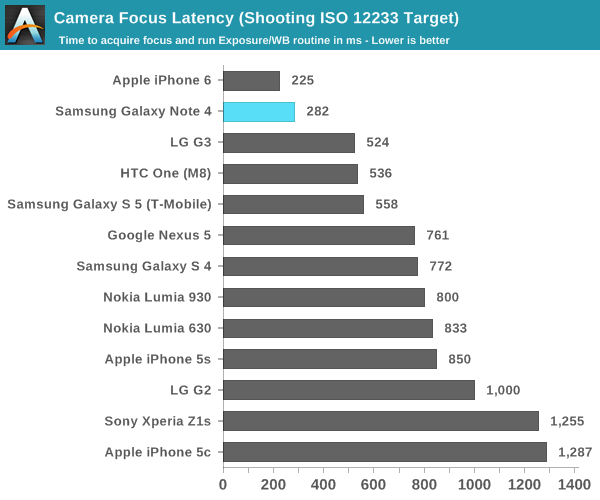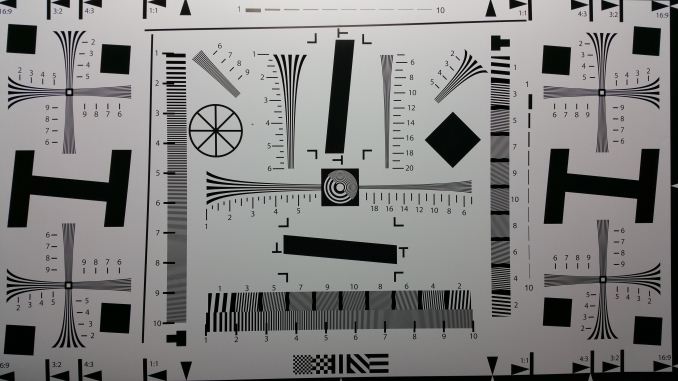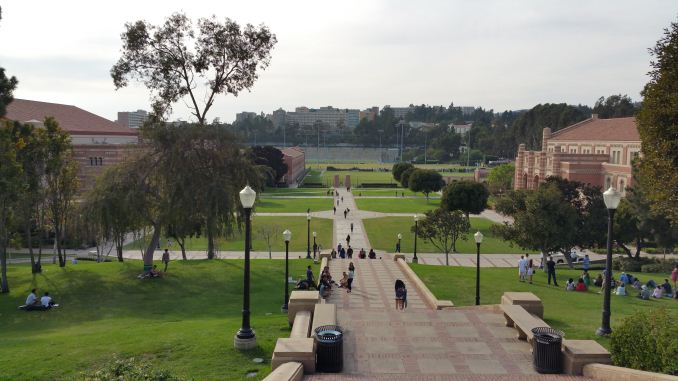The Samsung Galaxy Note 4 Review
by Joshua Ho on October 15, 2014 9:00 AM EST- Posted in
- Smartphones
- Samsung
- Android
- Mobile
- Galaxy Note 4
Camera
While the 16MP camera of the Galaxy Note 4 is mostly what we would expect, Samsung has really changed things up with the addition of OIS. Outside of this addition and the Sony IMX240 sensor, there’s really not a lot of change when it comes to the Galaxy Note 4. This means that we see the same 31mm equivalent focal length and F/2.27 aperture. At this point, it seems that OIS has finally reached mainstream adoption as both Samsung and Apple are shipping OIS solutions on their phones. The front facing camera is noticeably different though, with a Samsung S5K6D1YX sensor that I haven't seen elsewhere.
However, before we get into the proper image quality analysis I wanted to first cover shot to shot latency and focus/AE latency, as both are critical to a good image capture experience. Even if it’s possible to get amazing photos from a camera, it doesn’t really matter if the moment is missed. In order to test this, we look at the ideal case, which is when the phone is pointed at the ISO chart with bright lighting to maximize contrast.


As one can see in the graphs above, capture latency and focus latency are quite competitive with on the Note 4. However, there is one crucial detail that the focus latency graph misses, which is that Samsung doesn’t have continuous auto-focus in preview with the Note 4. As a result, there’s realistically an additional latency period before the auto-focus begins to run. The result is that the total time from out of focus to in focus is realistically closer to 800ms, but if one immediately taps the display to begin an AF run it’s possible to achieve the lower bound value, which is just south of 300ms.
Still Image Performance
While I'm still working on moving towards a better test for cameras, for now we have our standard photo comparisons that should give a good idea of what to expect from a smartphone camera in comparison to other cameras. Our first test is the standard ISO chart, which allows for a good test of maximum resolution.

For this first test, it seems that Samsung hasn't really changed much when it comes to maximum resolution, and in general the Note 4 produces similar output to the Galaxy S5. To verify this and a test of dynamic range, we'll look at a landscape shot next.
In this test, we see that the Galaxy Note 4 generally does well with detail and dynamic range as the landscape is generally well-detailed, although there's quite a bit of detail that seems to be smudged away on the grass as it seems to be a flat green texture for the most part. There's also noticeable color artifacting on the bleachers in the distance. We'll look at the same scene in low light to get a better idea for what the Note 4 really brings to the table.
Here, in low light we see significant improvements in image quality when comparing the Galaxy S5 to the Galaxy Note 4. The iPhone 6 Plus and Note 4 are quite close in overal quality, but looking at the brick building on the right of the image shows that the iPhone 6 Plus is maintaining a higher level of detail in this scene.
In the case of HDR, Samsung continues to do a great job with their implementation. For the most part this feature is successfully implemented with no real halos or other artifacts even when there are moving objects in the shot. This is likely to be implemented through on-sensor HDR rather than image combination.





































195 Comments
View All Comments
JoshHo - Monday, October 27, 2014 - link
As noted in the review, the Note 4 doesn't use PDAF for continuous AF so that number isn't representative of the total "AF speed" as there's significant lag between recognizing that a scene is out of focus and the start of the focus run.Drumsticks - Wednesday, October 15, 2014 - link
It really amazes me (and is a testament to their engineers) that the A8 seems to deliver near twice the IPC/per clock performance as Krait.Also: good review in general! I think phablets are too big for me, but I like keeping up with where the market likes to go.
Calista - Wednesday, October 15, 2014 - link
Fully agree, the Apple A-series are amazing. Half the frequency, half the core count, one third the memory and still the fastest SOC more often than not while still being very frugal.danbob999 - Wednesday, October 15, 2014 - link
CPU benchmarks are not designed to test the benefit of having more RAM. One could design a benchmark using 2GB RAM. The iPhone would be slower than a Galaxy S3 because it would be swapping (or even failing).Javascript benchmarks test the browser more than the CPU. That's why the iPhone 5s still performs well in these benchmarks even tough it has a very slow CPU with no ARMv8.
mudman - Wednesday, October 15, 2014 - link
Wikipedia states that the a7 in iPhone 5s is based on armv8-a.kokono - Wednesday, October 15, 2014 - link
Does this mean iPhone6+ lags when compared to the new Galaxy?melgross - Wednesday, October 15, 2014 - link
Android needs more RAM to begin with. It's not a useful comparison.tipoo - Wednesday, October 15, 2014 - link
That's true, but not to the point of making 1GB on iOS moot vs 2-3GB Android phones. It definitely swaps apps out of memory more.KPOM - Wednesday, October 15, 2014 - link
How many phone apps really use more than 1gb right now? The iPad Air 2 will have 2 GB and my guess is that the iPhone 6s will too. But for now 1GB is fine.akdj - Thursday, October 30, 2014 - link
You're entirely TOO WRONG!Lol, what crap. I've got a Note 3, specifically for my business. The 5s as my personal, daily driver. I love em both for different reasons. Especially with what we do, the stylus on the Note for when we're doing it ...& collecting the pay for it with our clients using the SPen to sign their credit card receipt.
Other than that...nope. Nothing is 'better' on the S3, 4, 5 or Note 3 than the iPhone 5s. Display preferences aside, as an owner of both, for over a year can attest to their performance. It's ridicukius realily. My Note, again being a business line doesn't have a whole lot of apps other than productivity, a couple of 'creative' types and some excellent games to kill time on sites.
Any and EVERY app in 'parity' (available on both platforms) overwhelmingly plays more fluently on the iPhone. Productivity, cloud access and any type of 'creative' apps are abound, and they're excellent ...well optimized to a single, specific type ID hardware
It's amazing to me, in a stock cold boot of a Note 3 (I've reset a couple times), it's ALREADY using 19-2.1GB of RAM! The OEM and carrier crap is a silly joke
Apps come to iOS first. Are optimized for a single platform (& able to be played for years, fluently and with updates!). Crazy, a ⅓ the RAM, twice the processors at twice the clock speed is definitely the more 'usable' system. Customizing aside, I enjoy my home screen but for seconds ...it's the apps, their design UI and ability to 'run with reliability'. That's where iOS Smokes iOS. Secondarily, it's for a vertical & horizontal system, ala OS X.
Android has Chrome
The SPIII is a nice piece. If Windows gets ohine's figures out, Samsung's screwed.
Oh, sorry. They already are!
Then there's the tablets. Windows, again ..the SPIII is special
The Air2, incredible.
There's NOT a comparable tablet running Android. Nor will Chromebooks become anything other than a home appliance.
Sorry. You certainty don't understand RAM.